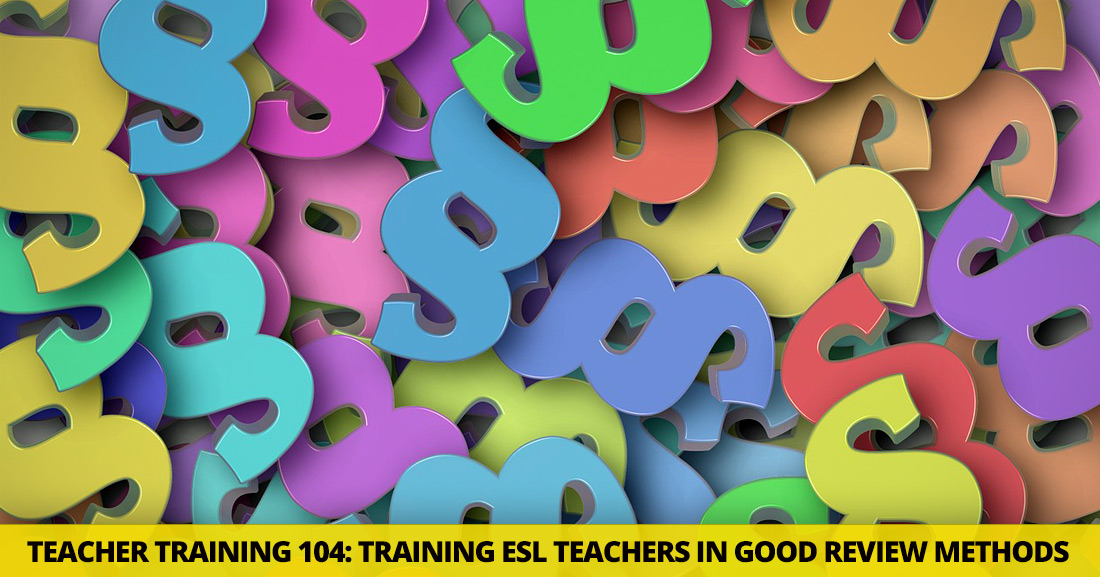I’ve Got the Book, but Now What? How to Take Grammar from the Textbook Pages into the Classroom


I noticed, for the first time, that twenty years have now passed since I graduated from high school, back in England. Where on Earth all that time has gone, I can’t say, but thinking back over those formative years, one distinctly unpleasant memory cropped up, again and again: revision.
This dreaded period, which comprised the two or three weeks before the end-of-term exams and would be known here in the US as ‘Review’, was probably my least favorite school experience. It involved sitting alone and mulling over my notes from the semester, in the hopes that they might remind me of the salient points of each course.
Now, I don’t know about you, but I was a pretty bad note-taker, and this task merely underlined how poorly I’d been concentrating. It was a lonely, unsatisfying time, and when I became a teacher, I was determined not to inflict such discomfort on my students.
Trainee teachers learn to build review into their lesson plans as part of the classic ESL template:
Review – Presentation – Practice – (More Review)
The question is: what should they review? How should they differentiate between the topics which should be reviewed, and those which might safely be taught once, and left alone? Furthermore, should this review take place as part of a daily routine, or in a concentrated burst just before the exams, as it did at my high school? I decided to sit down and organize my thoughts on the process of review, considering the why, when and how of this important learning tool.
My trainees know that I practice what I preach. In just the same way as I anticipate that they will regularly review new content with their students, I make a point of reviewing our own course content after three days, and again after a week. This has become a well-established routine, and my student-trainees know to expect it. But why is it important?
Research has repeatedly shown that refreshing one’s memory, especially the day after learning has taken place, reinforces the learning and helps information to pass into the long-term memory. You can experience this for yourself, if you like; take a few simple pieces of information and try to commit them to memory (a good example would be the names of sports champions over a five year period, or the four biggest moons of Jupiter). Tomorrow, revisit the information and see how much you’ve remembered. Do the same three days from now, and again after a week. I’m prepared to bet that information will never leave you and that, even during a pub quiz many years from now, you’ll still be able name Io, Europa, Ganymede and Callisto, and impress the heck out of everyone.
Review is also a chance to catch any problems we missed the first time around. These include problems of comprehension, pronunciation and structure; your students can show you that they’ve truly grasped the material, or alternatively, give you a chance to brush up their understanding. It’s also an opportunity to build on the material you’ve taught; why not add a few synonyms and antonyms to the vocabulary, or extend your students’ use of a structure with a few extra nuances?
The above pattern has been shown to work well:
Day Zero (learning day)
Day One (review A)
Day Three (review B)
Day Seven (final review)
Arguably, Day One could be omitted, but two minutes’ review won’t hurt.
Another question concerns where we might place review in our lesson structure. Classically, we begin the class with a review of the previous lesson’s material, but that’s not set in tablets of stone. As in most other things, I encourage my trainees to respond to their students’ needs, the size and composition of the group, the nature of the day’s target material, and other factors which are harder to categorize or describe – the vibe of the class, we might call it.
One good way to solve this problem is to make the review period extremely short. In a forty-minute lesson, more than five minutes’ review would be a lot; I’ve carried out one-minute reviews, tossing questions at my students in a ‘quick-fire’ pattern, just to make sure they can use the previous day’s material without trouble.
It also makes a lot of sense to review the day’s material at the end of class, but a lot of teachers prefer to leave this to the next class. In the meantime, your students should be encouraged to quickly review their notes before the class begins (arriving a few minutes early helps with this). All of this, of course, depends on good note-taking skills, something I emphasize with my trainees.
I’ve tried a lot of different methods, and it’ll become a matter of choosing what’s right for your class. Over the years, many teachers build up a library of review materials which can quickly be copied and handed out; this relieves the pressure of planning new exercises, and saves time. Here are my favorite methods, those which I encourage my trainees to experiment with:
| Teacher: | OK gang, what did you think of the reading? Pretty cool, right? |
| Student 1: | I didn’t know so many new dams were building in China. |
| Teacher: | (Pauses) Hang on a minute… |
| Student 2: | Uh-oh… |
| Students: | (Laughter) |
| Teacher: | Go again, would you? You didn’t know so many… (gestures for Student 1 to continue) |
| Student 3: | Is always your punishment! ‘Go again…’ |
| Teacher: | It’s not a punishment, it’s review! They’re very different. |
| Student 1: | I didn’t know so many new dams were being… Ah. I forget. |
| Student 2: | … Being built… Right, teacher? |
| Teacher: | (Thumbs up) Sounds good to me. (To Student 1) Want another try? |
| Student 1: | Er, no. |
| Students: | (Laughter) |
| Teacher: | Go on, impress me. |
| Student 1: | I didn’t know so many new dams were being… built in China. |
| Students: | (Applause) |
| Teacher: | Awesome. Can anyone name the problem structure there? |
| Student 4: | Kind of an active-passive problem. |
| Teacher: | Not only ‘kind of’, but ‘in fact’, I’d say. Do you guys feel like a little more review? |
| Students: | (All together, and with feeling) No! |
| Teacher: | Great! I’ll do the active, you give me the passive. Deal? |
| Student 2: | No deal. |
| Teacher: | You’re no fun. Here we go. ‘Two hundred workers built the museum’. Passive, please? |
| Student 4: | The museum was built by two hundred workers. |
| Teacher: | I love it. Next one… |
It might take time for a new teacher to create review materials for each session, but after a few months or years, they’ll build up a large library of great content, ready to be copied and distributed. Writing your own review exercises also brings the teacher into contact with the material in a creative way, which is always positive. Studying the concept of review in this way also reveals that the overall class structure is itself flexible, and can be responsive to the individual needs of the students.